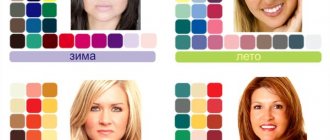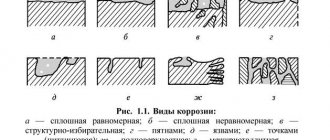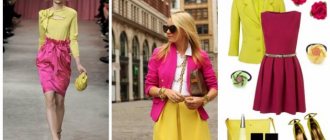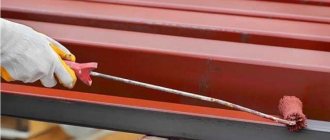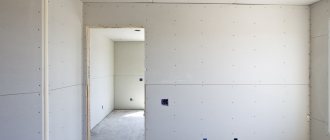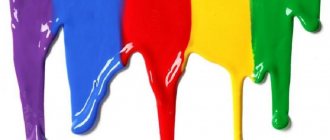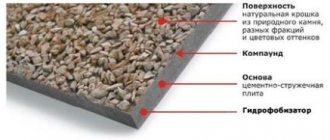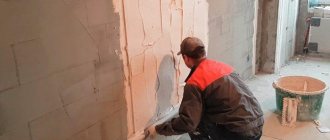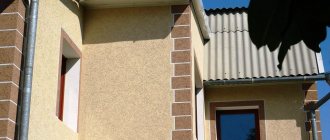Choosing paint for the stove
The operating temperature for standard metal paint does not exceed 40-50 ℃, so you cannot paint surfaces that are too hot - it will bubble up, lose its original color and may begin to smoke and smell unpleasant. Therefore, in this case, you need to use only special heat-resistant paint for stoves.
Which of the proposed paint options to choose will depend on the area of its application. Thus, a metal sauna stove can heat up to 600-800 ℃ or more - at the epicenter of combustion the temperature is even higher. But its outer walls may not heat up so much - it all depends on the design. If we are talking about a brick oven, then its surface does not warm up above 200 ℃.
Please note that heat-resistant paint must be suitable for interior use. And for sauna stoves you need paint with moisture protection.
Technical characteristics, properties of aluminum powder
Fine powder contains from 82 to 92% active aluminum. Covering capacity is 10 g/m2. Powder density – 0.15 – 0.3 g/cm3. Residue on sieves 008 – 0 – 0.3%. The content of organic components is 3 – 4%. Aluminum powder must be homogeneous, without visually visible large fractions.
A very useful property of aluminum powder is its tendency to “sheet”. When painting, the powder does not remain in the thickness of the paint layer. The plates float up and are located parallel to the surface, partially overlapping each other. The ability to “sheet” depends on the composition of the lubricant covering each particle, on the properties of the solvent and the film-forming base of the paint and varnish material. The powder adheres well to steel surfaces.
A little about the types of heat-resistant paints
Painting very hot surfaces of metal furnaces can only be done with heat-resistant, heat-resistant and fire-resistant paints. But fire retardants are not suitable in this case - they are used for other purposes. When heated to 200 ℃, fire-retardant paint swells and blocks the access of oxygen to the structure, protecting it from destruction in fire. Let's take a closer look at the types of paints.
So, heat-resistant paint for stoves is used at a temperature threshold of 600 ℃. Such compositions are suitable for painting metal elements of stoves and fireplaces, as well as for metal heating appliances. But for sauna stoves they use several different types of materials - heat-resistant enamel, which is designed to heat the surface to 800-1000 ℃.
Fireproof paint for metal products can withstand exposure to open flames. Therefore, its temperature threshold is even higher. However, due to the very high cost, it is not advisable to use such compositions at home.
Another type of paint is high-temperature. Their area of application is painting heating batteries and a number of engine components. As a rule, such compositions are operated under heating conditions no higher than 200 ℃. High-temperature paint for brick stoves can only be used if it is necessary to tint the surface or paint the seams. Metal stoves cannot be painted with it.
For brick stoves, you can also use heat-resistant varnish. Its operating temperature is 250-300℃. After treating the surface with this varnish, it becomes shiny and brighter.
Bronze powder
Bronze powders BPF and VPK mixed with liquid or gaseous oxygen burn intensely, but do not explode.
Mixtures of bronze powders BPF and VPC with calcined and hydrophobic airgel in a liquid oxygen environment do not explode regardless of the powder content in them. A mixture of powder and hydrophobic airgel burns intensely in gaseous oxygen at any powder content.
Commercial powder used to prepare bronze paint is used as bronze powder.
A mixture of airgel with bronze powder FPF is used in the manufacture of tanks for liquefied gases and, in comparison with pure airgel and perlite, makes it possible to reduce the heat flow through an insulation layer of the same thickness by 3-4 times.
A similar effect is achieved by adding bronze powder to white soot BS-280 and Aerosil A-380. At the same time, the mixture with white soot has a slightly lower coefficient of thermal conductivity than the mixture with airgel, and the mixture with aerosil has a slightly higher coefficient. Considering the significantly lower cost of aerosil, it is advisable to use it instead of airgel in most products insulated with a mixture of BPI powder.
When insulated with a mixture of airgel and bronze powder, the amount of loss is reduced to 0.45 kg/h for nitrogen and to 0.40 kg/h for oxygen, or to 0.72% per day. The reduction in losses when filling shielded powder is relatively small due to the large heat flow through thermal bridges. According to calculations and tests, the heat flux through the supports, hangers and pipes is 19 5 W, which corresponds to 0 33 kg / h of oxygen, or approximately 50% of the total losses during airgel insulation. The heat gain through the insulation in the case of shielded powder is 4 0 W, which corresponds to losses of 0 07 kg / h, or 0 13% per day. Consequently, the use of shielded vacuum powder insulation can have a significant effect while simultaneously improving the tank design to reduce heat flow through hangers, supports and pipes.
The most commonly used powdered metal pigments are aluminum and bronze powder.
IMASH, when adding 50% FFT bronze powder to the airgel, the thermal conductivity coefficient at 90 K decreases from 0.0013 kcal. This is explained by the mutual reflection of thermal infrared rays by metal particles of powder in the insulating space; As a result, the heat flow to the liquid as a result of radiation is significantly reduced.
Materials filled with a mixture of bronze powder and copper formate or salicylate have a higher load capacity. These compositions are used to coat worn brake hydraulic cylinders of automobiles, as well as the inner surface of pump-compressor pipes of oil wells operated with rod pumps.
In tanks for liquefied gases, a mixture of airgel with bronze powder is used in the amount of 100 kg per 1 m3 of isolated space. The addition of metal powders to vacuum powder insulation reduces heat flow through the insulation by 3-4 times.
According to VNIIKIMASH, when 50% FFT bronze powder is added to the airgel, the thermal conductivity coefficient at 90 K decreases from 0.0013 kcal / (m-h-deg) with a residual pressure of 1 10 - 2 mm Hg. Art. up to 0 00035 kcal.
How to choose the right one
To choose the right paint for the stove, you need to carefully consider the label, which says what surface it can be used for, for example, heat-resistant paint for metal products. Often this information is printed in large font and is difficult to miss. In cases where the scope of application of paint and varnish products is wide, this is also written on the packaging, but in small print. Be that as it may, such information must be indicated on the packaging, as well as the name of the manufacturer. If this data is not available, there is no need to purchase such a product. It is possible that this is a counterfeit product that may pose a threat to your health.
For metal sauna stoves, use only moisture-resistant compounds, otherwise they will not last long on the surface.
Packaging
You can purchase heat-resistant paints in various packaging - these can be spray cans or jars. From cans, paint is simply sprayed over the surface, and from a can, paint is used with brushes, rollers or special sprayers.
The volume of the cylinder is usually 500 ml. Cans are produced in 400 g, 800 g, 2.5 kg and 5 kg. There are also large buckets of 5-15 kg and barrels.
Exactly how to apply thermal paint is everyone’s personal choice. For some, it will be more convenient to use a brush or roller, while others will opt for a spray can. In the latter case, the material consumption will be significantly lower, and the paint will apply more evenly and evenly.
Traditional methods of removing paint
Until the paint has dried, it is enough to use a rag soaked in solvent. The product must comply with the recommendations for the varnish or drying oil used. From metal surfaces, hard plastic and glass, the hardened mass can be carefully scraped off with a blade.
If the coloring was done with factory-made silver, then folk methods will help. The most affordable remedy is vegetable oil. Cover the dirty area with it for 10-15 minutes. Then the stain is wiped with a dry, rough cloth. The process is repeated if necessary. Another option involves applying nail polish remover (only without acetone in the composition) for 5-7 minutes. The softened film should simply be washed off with water.
Nail polish remover without acetone Source www.fdvor.ru
Which fireproof paint to choose for the stove
Paint for metal stoves must be selected with a temperature threshold of 600 ℃ or more. Here are a few of the most famous brands with a brief description of each.
Heat-resistant enamel of the CERTA brand, produced by the domestic manufacturer Spectrum. It is designed for use in the temperature range of 65-900 ℃, and its application can be carried out even in frosty temperatures of -30 ℃. The consumer is offered a total of 26 shades of paint, including turquoise, blue and yellow. True, not all colors withstand equally high temperatures. Thus, the most heat-resistant color is black (up to 900 ℃). Behind it are white, gold, brown, copper, red-brown, green, blue, cyan and turquoise (all of them can withstand up to 750 ℃).
All other shades can be used at temperatures not exceeding 400-500 ℃. This paint is produced in cylinders, cans and buckets of various sizes.
Termal paint from the Finnish manufacturer Tikkurila. It is made on the basis of alkyd resins and is available in black and silver. It is able to withstand the heating of the metal at the stage when it turns red. When using this paint on sauna stoves, it does not crack or peel for about 3 years. Please note that if you heat the painted surface to 230℃, it will dry in 1 hour. This is a prerequisite for its polymerization.
Hansa brand heat-resistant metal stove paint comes in 16 colors and can be used in temperatures up to 800℃ to paint stainless steel. It goes on sale in barrels, cans and cans.
Heat-resistant paint of the Kudo brand, produced in Russia, is a silicone enamel for metal products. It is designed to heat the surface up to 600 ℃ and is available in 20 shades, including white, black, red and silver. Sold in 520 ml bottles.
Aerosol paint Bosny. Available in two versions - for heating up to 650 ℃ and up to 200 ℃. It fits well, does not change color for a long time and does not crack. This brand of thermal paint is used for painting metal, plastic, ceramics and glass, wood and fabrics. Pay attention to this brand, since glass paint is rare to find. The container capacity is 400 ml.
Hammerite brand heat-resistant metal paint has one feature. It can even be applied over rust without first cleaning the surface. However, beware of its contact with diesel fuel, gasoline and grease.
The paint can withstand heating up to 600 ℃ and is available in 250 ml cans. It is applied with a brush.
Anti-corrosion heat-resistant ELCON enamel can withstand temperatures up to 800 ℃, including sudden changes. Used for painting concrete, brick and metal. Available in cans in a large number of colors. There is also an aerosol version of ELCON paint in 520 ml cans - it is designed to heat up to 700 ℃.
Paint for metal and other surfaces KO-8111 “Termika” can withstand up to 600 ℃. In addition, it has a protective effect against stray currents, salts, chlorine, solutions, oils and aggressive substances. Used for painting fireplaces and stoves. In baths, it is better to use the KO-8101 brand and KO-8104 primer from the same manufacturer. In addition to heat resistance, this paint is also moisture resistant.
Rust-Oleum heat-resistant paint is designed for very high heat - up to 1093 ℃. In addition, it protects against gasoline and oils. Release form: aerosol can. It comes in matte white, gray, black and transparent.
All of the above options are successfully used for painting brick and metal heating stoves and boilers. And some are also suitable for sauna stoves.
Composition of silverfish
Dry silver is aluminum powder, that is, aluminum production waste crushed to the consistency of a suspension. Silver metal powder has a distinct “silver” color. It is thanks to this that the paint got its name “silver”. Paint is most often made from metal powder by adding and mixing with bitumen varnish. Synthetic drying oil is also used for dilution.
When pigment is added, silver paint can take on a bronze or golden color. Thus, on the basis of the powder, coloring substances of different colors are created, with a characteristic metallic sheen.
Tip 1: How to breed silverfish
Sometimes the surface can be coated with rust converters, but this must be indicated on the paint package. Upon completion of treatment, the surface must be washed and dried. Rust must be removed completely, down to the smallest specks.
In each case, the required number of paint layers and their direction are purely individual. If more than one layer is required, they are applied in different directions so that the paint goes on more evenly.
The temperature and drying conditions of the paint, as well as the gap between application of layers, are always indicated on the label. Following the manufacturer's recommendations will allow you to obtain a coating that will last the specified period.
